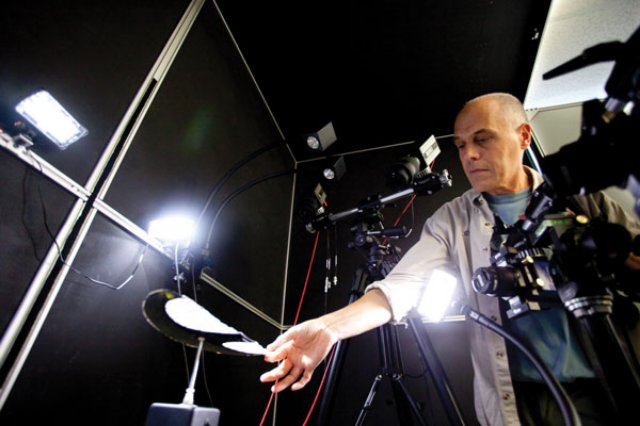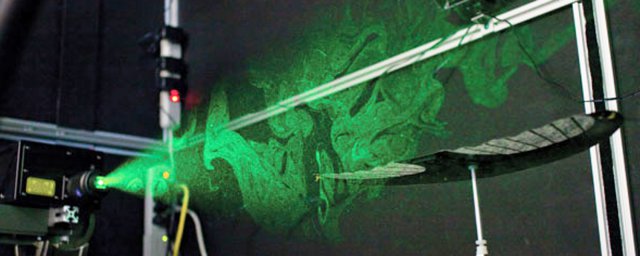 Light-as-a-feather, fiber-reinforced carbon composites give Roberto Albertani an edge in designing unusual aircraft: micro air vehicles that you can hold in the palm of your hand. Such fliers could respond to disasters inside buildings or collect data under tree canopies. To design them, the OSU mechanical engineer studies how they interact with the air.
Light-as-a-feather, fiber-reinforced carbon composites give Roberto Albertani an edge in designing unusual aircraft: micro air vehicles that you can hold in the palm of your hand. Such fliers could respond to disasters inside buildings or collect data under tree canopies. To design them, the OSU mechanical engineer studies how they interact with the air.
And for that, he relies on a common cooking ingredient: olive oil. Air currents swirl through laser light as they move over an experimental wing. Roberto Albertani uses olive oil particles to reveal air movement.
In a room the size of a walk-in closet, he sprays a fine oil mist into the air. At the same time, air blows out of a device that looks like a hair dryer and moves over and under a test aircraft anchored to a platform. The air may be invisible, but lasers illuminate the airborne olive oil particles, telling the researcher where the air speeds up or eddies as it moves across the wings. High-speed cameras capture the action at 500 frames per second.
“Ultimately we design something that we can build,” Albertani says, “something that can be manufactured in large numbers.” Albertani, an expert in composite materials, co-holds two patents for micro air vehicles. He demonstrates one of them by taking a sleek, black airplane off the top of a filing cabinet and wrapping the wings under the fuselage into a package you could put in your coat pocket. Take it out, and the wings snap back into position, ready to fly.
Equipped with a video camera, such a plane could fly over nearby terrain and relay images back to the sender. “If you’re fighting a fire in the forest, you could throw this into the air and get a look at everything around you,” he says.
To understand how micro air vehicles should be designed, Albertani looks to nature — in this case, bat wings. He picks up another plane about the size of a coffee cup. In the middle of its slick carbon-fiber wing surface sits a thin latex skin like a patch over a hole. As air moves over the wing, he explains, the latex can flex to add lift and maneuverability. The idea came from Peter Ifju, a windsurfer and Albertani’s Ph.D adviser at the University of Florida.
 In a separate project, Oregon State University students worked with Belinda Batten to understand how bats control flight through cells on their wings. With funding from the Air Force Office of Scientific Research, they used engineering principles to show that some cells sense air-pressure changes. Moreover, the cells are linked to muscles that course through the wing. The result of this natural design — a system that engineers call “co-located actuators and sensors” — is familiar to anyone who has marveled at bats as they dart after insects at dusk. Without the familiar control structures we see on airplanes, bats’ flexible membrane wings demonstrate dramatic agility.
In a separate project, Oregon State University students worked with Belinda Batten to understand how bats control flight through cells on their wings. With funding from the Air Force Office of Scientific Research, they used engineering principles to show that some cells sense air-pressure changes. Moreover, the cells are linked to muscles that course through the wing. The result of this natural design — a system that engineers call “co-located actuators and sensors” — is familiar to anyone who has marveled at bats as they dart after insects at dusk. Without the familiar control structures we see on airplanes, bats’ flexible membrane wings demonstrate dramatic agility.
Albertani is also studying the flight behaviour of butterflies. “Butterflies are incredibly interesting fliers,” he says. “They have low wing loading, which means they are very light and have a high wing surface. It makes the flier intrinsically slow. Nevertheless, they can dash fast and are very agile. They can maneuver in small spaces.”
Albertani continues to develop his designs and to test them in OSU’s wind tunnel. He also advises the student chapter of the American Institute of Aeronautics and Astronautics, which competes in an annual DBF (design, build, fly) competition.
Photos: Jeff Basinger
Source: Kawak Aviation
